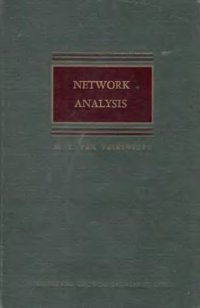
Ebook: Network analysis
Author: Van Valkenburg Mac E.
- Genre: Technique // Electronics: Electronics
- Series: Prentice-Hall electrical engineering series
- Year: 1959
- Publisher: Prentice-Hall
- City: Englewood Cliffs, NJ
- Edition: 6. print.
- Language: English
- djvu
This book is designed for use as an introduction to the study of electric networks from the so-called pole and zero approach. The subject matter may be divided into four parts.
(1) Chapters 1 through 3 are concerned with definitions and with the formulation of equilibrium equations. The first chapter contains a discussion of approximation as it relates to networks, the relationship between the network abstraction and the physical system. Here the reader is given the opportunity to plant his feet firmly on the ground before he becomes involved in the myriad details of analysis. The elements are introduced, their laws formulated, their combination into networks discussed. Writing of equilibrium equations for networks is treated in Chapter 3.
(2) Chapters 4 through 8 have to do with the solution of equilibrium equations, integrodifferential equations in general, by both classical and the Laplace transform method. Chapter 8 amplifies the relationship between the time domain and the frequency domain. These first eight chapters encompass topics classified under the heading of transient analysis of electric circuits. In the remaining chapters, this background is exploited in unifying concepts of transient response and sinusoidal steady-state response by the use of the poles and zeros of network functions.
(3) In Chapters 9 through 11, the reader is introduced to complex frequency, impedance functions, transfer functions, and poles and zeros.
(4) The remaining chapters are devoted to applications of the pole and zero approach to network analysis. Chapters 12 and 13 relate to reactive networks and include Foster’s reactance theorem and filters studied from the image parameter point of view. Chapter 14 is an introduction to stagger-tuned amplifier-networks. In the last two chapters, the representation of systems by block diagrams and the stability of feedback systems are studied. References are given at the end of each chapter for those interested in a more advanced or more detailed study.
(1) Chapters 1 through 3 are concerned with definitions and with the formulation of equilibrium equations. The first chapter contains a discussion of approximation as it relates to networks, the relationship between the network abstraction and the physical system. Here the reader is given the opportunity to plant his feet firmly on the ground before he becomes involved in the myriad details of analysis. The elements are introduced, their laws formulated, their combination into networks discussed. Writing of equilibrium equations for networks is treated in Chapter 3.
(2) Chapters 4 through 8 have to do with the solution of equilibrium equations, integrodifferential equations in general, by both classical and the Laplace transform method. Chapter 8 amplifies the relationship between the time domain and the frequency domain. These first eight chapters encompass topics classified under the heading of transient analysis of electric circuits. In the remaining chapters, this background is exploited in unifying concepts of transient response and sinusoidal steady-state response by the use of the poles and zeros of network functions.
(3) In Chapters 9 through 11, the reader is introduced to complex frequency, impedance functions, transfer functions, and poles and zeros.
(4) The remaining chapters are devoted to applications of the pole and zero approach to network analysis. Chapters 12 and 13 relate to reactive networks and include Foster’s reactance theorem and filters studied from the image parameter point of view. Chapter 14 is an introduction to stagger-tuned amplifier-networks. In the last two chapters, the representation of systems by block diagrams and the stability of feedback systems are studied. References are given at the end of each chapter for those interested in a more advanced or more detailed study.
Download the book Network analysis for free or read online
Continue reading on any device:

Last viewed books
Related books
{related-news}
Comments (0)